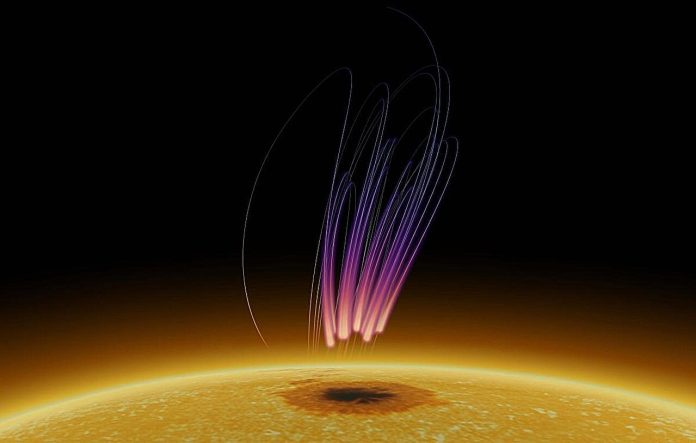
A team of astronomers from the New Jersey Institute of Technology’s Center for Solar-Terrestrial Research (NJIT-CSTR) has made an exciting discovery involving a sunspot, a dark and cooler area on the sun.
They have observed a unique radio emission coming from a sunspot, similar to the auroral displays seen on Earth and other planets.
This new finding, detailed in Nature Astronomy, could change our understanding of solar and stellar phenomena.
Lead author and NJIT-CSTR scientist Sijie Yu explains that they have detected a strange type of radio burst, lasting over a week, coming from a sunspot.
This is different from the usual short-lived solar radio bursts and could revolutionize our knowledge of how magnetic fields work in space.
The Aurora Borealis and Aurora Australis on Earth are famous examples of auroras, created when solar activities disturb Earth’s magnetosphere.
This leads to charged particles precipitating into the Earth’s polar regions, where they interact with atmospheric gases, creating beautiful light displays. These interactions also produce intense radio emissions at certain frequencies.
The solar radio emissions observed by Yu’s team are unique. They were found over a large sunspot area where the sun’s magnetic fields are exceptionally strong.
These emissions differ from known solar radio storms in their spectrum and duration.
The team suggests that these emissions are caused by a process called electron-cyclotron maser (ECM) emission. This involves energetic electrons trapped within magnetic fields.
Sunspots, being cooler and highly magnetic, provide the right conditions for ECM emissions. This discovery draws parallels between the sun’s magnetic processes and those seen in the magnetic polar regions of planets and stars.
Unlike Earth’s auroras, these sunspot emissions occur at much higher frequencies due to the sunspot’s significantly stronger magnetic field.
The study also involved scientist Rohit Sharma from the University of Applied Sciences Northwestern Switzerland (FHNW).
He notes that these radio bursts are not directly linked to solar flares. Instead, sporadic flare activities nearby seem to inject energetic electrons into magnetic field loops connected to the sunspot, powering the ECM radio emission.
This “sunspot radio aurora” appears to rotate with the sun, creating what Yu describes as a “cosmic lighthouse effect.”
As the sunspot moves across the solar disk, it emits a rotating beam of radio light, similar to the modulated radio auroras observed from rotating stars.
The researchers are excited about this discovery, believing it could be a model applicable to other stars with starspots. Associate Professor Bin Chen, a co-author, likens these solar radio emissions to auroral emissions observed on other stars, suggesting a possible commonality in stellar phenomena.
The team is now looking back at previous solar burst records to see if any could be instances of this new type of emission. They believe this discovery could have broader implications, helping astrophysicists rethink models of stellar magnetic activity.
NJIT solar researcher Surajit Mondal emphasizes the importance of understanding these phenomena on our sun to better interpret emissions from other stars, particularly M-dwarfs, the most common star type in the universe.
Dale Gary, NJIT-CSTR distinguished professor of physics, adds that understanding these signals from our sun can reveal fundamental connections in astrophysical phenomena.
To make this discovery, the team used broadband dynamic radio imaging spectroscopy observations from the Karl G. Jansky Very Large Array. The research team also includes collaborators Marina Battaglia from FHNW and Tim Bastian of the National Radio Astronomy Observatory.
Follow us on Twitter for more articles about this topic.
Source: KSR.



